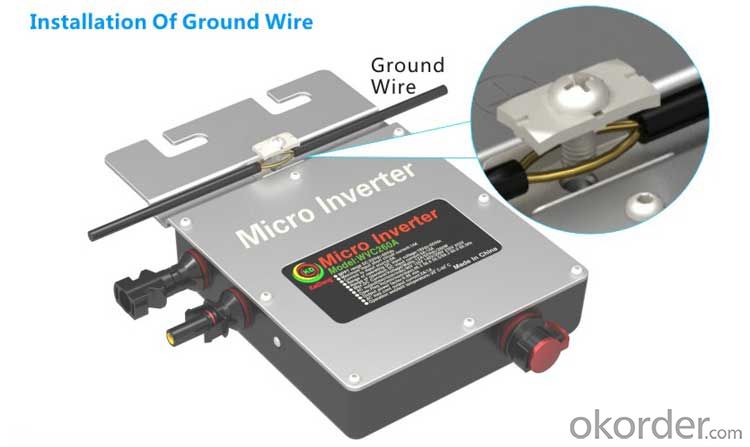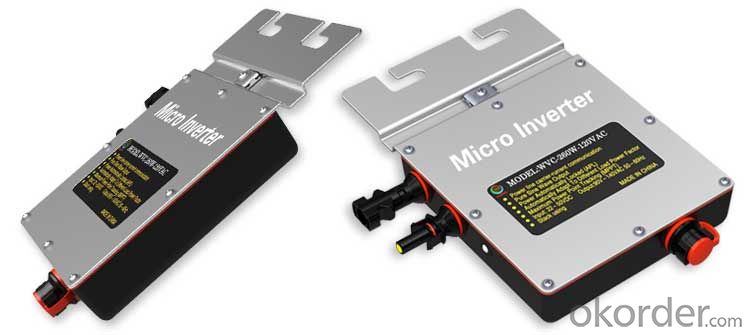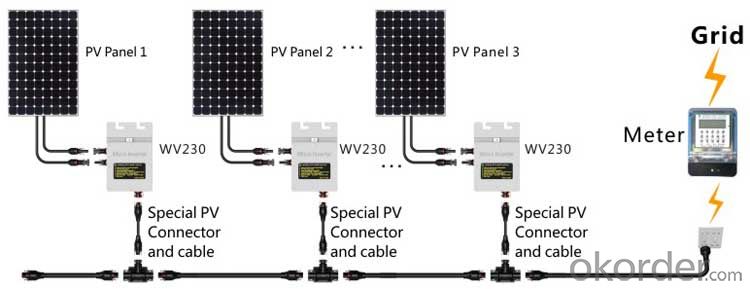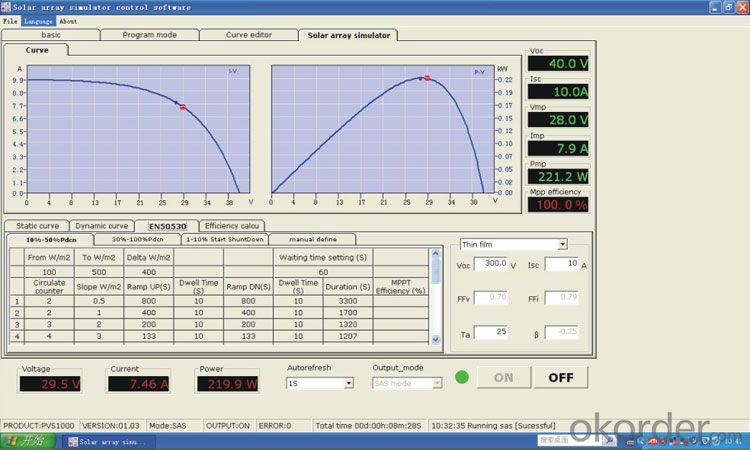KD-WV250 Series Micro Inverter,High Efficiency & Best Cost-Effectiveness
- Loading Port:
- China main port
- Payment Terms:
- TT OR LC
- Min Order Qty:
- 1000 pc
- Supply Capability:
- 100000 pc/month
OKorder Service Pledge
OKorder Financial Service
You Might Also Like
Structure
DC input voltage range:22-50VDC
AC output voltage range:80-160VAC/180-260VAC
AC output power :260Wp
AC frequency range:50Hz/60Hz
G.W.:0.85kg
Size:250mm*200mm*60mm
KD-WV250 Series Using IP65 waterproof streamline design, Can effectively prevent rainwater on the surface erosion, Built-in high-performance Maximum Power Point Tracking(MPPT)Function,Better able to track changes in the solar luminosity and control different output power, Effectively capture and collect sunlight. AC electric power transmission using the reverse transmission technology, Is one of our patented technology, The inverter output power can provide load priority use, Extra electricity to the grid, Efficient use of the inverter to the power emitted, Electricity transmission rate of up to 99%.
Features
Pure Sine Wave Output;
High performance Maximum Power Point Tracking(MPPT);
Power Automatically Locked(APL);
Reverse power transmission;
High-Frequency High Conversion Rate;
Anti-Islanding Protect;
Input /output is fully isolated to protect the electrical safety;
Multiple parallel stacking;
The Leading Patent Technology;
IP65 WaterProof;
Flexible Installation;
Simplify maintenance (user serviceable)
High Efficiency & Best Cost-Effectiveness
Images


Specification
Input Data | KD-WV250-120VAC/230VAC | |||
Recommended input power | 200-300Watt | |||
Recommend the use of PV modules | 300W/Vmp>34V/Voc<50V | |||
Maximum input DC voltage | 50V | |||
Peak power tracking voltage | 25-40V | |||
Operating Voltage Range | 17-50V | |||
Min / Max start voltage | 22-50V | |||
Maximum DC short current | 15A | |||
Maximum Input Current | 9.8A | |||
Output Data | @120VAC | @230VAC | ||
Peak power output | 260Watt | 260Watt | ||
Rated output power | 250Watt | 250Watt | ||
Rated output current | 2.08A | 0.92A | ||
Rated voltage range | 80-160VAC | 180-260VAC | ||
Rated frequency range | 57-62.5Hz | 47-52.5Hz | ||
Power factor | >96% | >96% | ||
Maximum units per branch circuit | 15PCS(Single-phase) | 30PCS(Single-phase) | ||
Output Efficiency | @120VAC | @230VAC | ||
Static MPPT efficiency | 99.5% | 99.5% | ||
Maximum output efficiency | 92.3% | 94.6% | ||
The average efficiency | 91.2% | 93.1% | ||
Night time power consumption | <50mW Max | <70mW Max | ||
THDI | <5% | <5% | ||
Exterior | ||||
Ambient temperature | -40°C to +60°C | |||
Operating temperature range (inverter inside) | -40°C to +82°C | |||
Dimensions (WxHxD) | 191mm*1176mm*38mm | |||
Weight | 0.83kg | |||
Waterproof Rating | IP65 | |||
Cooling | Self-cooling | |||
Feature | ||||
Power transmission mode | Reverse transfer, load priority | |||
Electromagnetic compatibility | EN50081.part1EN50082.part1 | |||
Grid disturbance | EN61000-3-2 Safety EN62109 | |||
Grid detection | DIN VDE 1026 UL1741 | |||
Certificate | CEC,CE National patent technology | |||



FAQ
Can we visit your factory?
Surely, I will arrange the trip basing on your business schedule.
Can you do OEM for us?
Yes, we can.
How do you pack your products?
We have rich experience on how to pack the panels to make sure the safety on shipment when it arrives at the destination.
Can you help us install the module if we cooperate with you?
We haven’t entered into installation sector, but we have the plan in near future.
- Q:Can a solar inverter be used with a net metering system?
- Yes, a solar inverter can be used with a net metering system. A solar inverter is an essential component of a solar power system as it converts the direct current (DC) generated by solar panels into usable alternating current (AC) electricity. Net metering allows for the excess electricity produced by the solar panels to be fed back into the grid, resulting in credit or compensation from the utility company. The solar inverter facilitates this process by ensuring that the electricity generated by the solar panels is synchronized with the grid, allowing for seamless integration and net metering.
- Q:Can a solar inverter be used for off-grid systems?
- Yes, a solar inverter can be used for off-grid systems. In fact, it is an essential component of off-grid solar systems as it converts the DC (direct current) electricity generated by the solar panels into AC (alternating current) electricity that can be used to power household appliances and other electrical devices.
- Q:How do you calculate the power output of a solar inverter?
- To calculate the power output of a solar inverter, you need to multiply the input voltage by the input current. This will give you the input power. Then, multiply the efficiency of the inverter by the input power to get the output power.
- Q:Can a solar inverter be used in regions with high levels of electromagnetic interference?
- Yes, a solar inverter can be used in regions with high levels of electromagnetic interference. However, it is important to ensure that the inverter is designed and manufactured to meet the necessary electromagnetic compatibility (EMC) standards and has the appropriate shielding measures in place to minimize any interference or disruption caused by electromagnetic noise.
- Q:Can a solar inverter be used with solar-powered desalination systems?
- Yes, a solar inverter can be used with solar-powered desalination systems. A solar inverter is responsible for converting the direct current (DC) produced by solar panels into alternating current (AC) that is required for the operation of desalination systems. By integrating a solar inverter, solar energy can efficiently power the desalination process, making it a sustainable and eco-friendly solution for water purification.
- Q:What is the role of capacitors in a solar inverter?
- The role of capacitors in a solar inverter is to store and release electrical energy in order to regulate and smooth out the flow of power. They help to stabilize the voltage levels, filter out any fluctuations or noise in the electrical signal, and provide a reserve of power for sudden increases in demand. Capacitors also improve the overall efficiency and performance of the solar inverter by reducing the strain on other components and preventing damage from power surges or spikes.
- Q:How does a solar inverter affect the overall energy consumption of a property?
- A solar inverter affects the overall energy consumption of a property by converting the direct current (DC) electricity produced by solar panels into alternating current (AC) electricity that can be used to power electrical appliances and equipment in the property. It ensures that the electricity generated by the solar panels is compatible with the property's electrical system, reducing the dependence on grid-supplied electricity. By efficiently converting solar energy into usable electricity, a solar inverter helps to lower the property's energy consumption from traditional sources and can potentially result in energy cost savings.
- Q:Can a solar inverter be used with different types of power control devices?
- Yes, a solar inverter can be used with different types of power control devices. Solar inverters are designed to convert the direct current (DC) generated by solar panels into alternating current (AC) that can be used to power household appliances and other electrical devices. They can be integrated with various power control devices such as charge controllers, battery banks, and grid-tie systems to optimize the energy output and manage the flow of electricity efficiently.
- Q:What is the maximum AC power output of a solar inverter?
- The maximum AC power output of a solar inverter depends on its size and capacity. Generally, residential solar inverters have a maximum AC power output ranging from 1 kilowatt (kW) to 10 kW, while larger commercial or utility-scale inverters can have outputs exceeding 1 megawatt (MW).
- Q:What are the common maintenance requirements for a solar inverter?
- The common maintenance requirements for a solar inverter include regular inspections to ensure proper functioning, cleaning of the unit and its components to remove dust and debris, checking and tightening of electrical connections, monitoring for any signs of damage or wear, and updating firmware or software as needed. Additionally, keeping the inverter's surrounding area clean and free from obstructions is also important for optimal performance.
1. Manufacturer Overview |
|
|---|---|
| Location | |
| Year Established | |
| Annual Output Value | |
| Main Markets | |
| Company Certifications | |
2. Manufacturer Certificates |
|
|---|---|
| a) Certification Name | |
| Range | |
| Reference | |
| Validity Period | |
3. Manufacturer Capability |
|
|---|---|
| a)Trade Capacity | |
| Nearest Port | |
| Export Percentage | |
| No.of Employees in Trade Department | |
| Language Spoken: | |
| b)Factory Information | |
| Factory Size: | |
| No. of Production Lines | |
| Contract Manufacturing | |
| Product Price Range | |
Send your message to us
KD-WV250 Series Micro Inverter,High Efficiency & Best Cost-Effectiveness
- Loading Port:
- China main port
- Payment Terms:
- TT OR LC
- Min Order Qty:
- 1000 pc
- Supply Capability:
- 100000 pc/month
OKorder Service Pledge
OKorder Financial Service
Similar products
New products
Hot products
Hot Searches
Related keywords






























